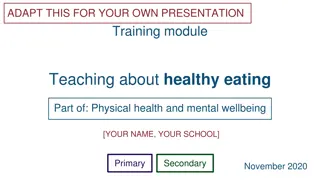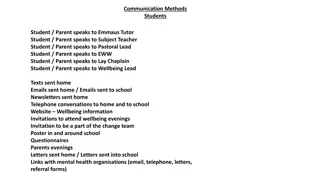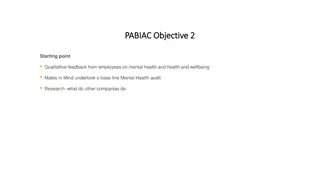Teaching Mental Wellbeing in Health Education: Training Module Overview
This training module provides valuable insights into teaching mental wellbeing as part of health education in primary and secondary schools. It covers the new curriculum requirements, examples of good practices, and activities for trainers. Schools are encouraged to adapt the module according to their needs and refer to statutory guidance for pedagogical support. Emphasizing the importance of understanding wellbeing factors, the module aims to equip educators with the knowledge and capability to address mental health challenges effectively.
Download Presentation

Please find below an Image/Link to download the presentation.
The content on the website is provided AS IS for your information and personal use only. It may not be sold, licensed, or shared on other websites without obtaining consent from the author. Download presentation by click this link. If you encounter any issues during the download, it is possible that the publisher has removed the file from their server.
E N D
Presentation Transcript
Training module Teaching mental wellbeing Part of: Health education Primary Secondary June 2020
Contents 3 About this training module 4 Teaching the new curriculum 13 Primary curriculum 30 Secondary curriculum 49 Examples of good practice 50 Activities and templates for trainers 2
About this training module This non-statutory training module supplements the statutory guidance on teaching mental wellbeing, which schools should read in full. Schools can choose whether and how to follow or adapt this training module and should refer to the Early Career Framework for pedagogical guidance. Subject leads using this presentation in training should also refer to the Activities and templates for trainers section. 3
Knowledge and capability From September 2020 there are new requirements for teaching mental wellbeing as part of health education. Statutory guidance explains how this knowledge will benefit pupils. STATUTORY GUIDANCE young people are increasingly experiencing challenges The new subject content will give them the knowledge and capability to take care of themselves and receive support if problems arise. (p4) 5
Primary and secondary teaching Some slides in this training have a Primary or Secondary label to indicate that the material is usually first introduced in that phase. Schools have flexibility to design and plan age-appropriate subject content (statutory guidance). Using your knowledge of your pupils and school community you can: introduce secondary material in primary with pupils who are ready teach the primary material in early secondary lessons to pupils who need to build knowledge before secondary requirements are taught 6
Start with wellbeing The majority of children and young people have good mental wellbeing most of the time. The starting point should therefore be teaching pupils the factors that contribute to and help us maintain wellbeing. Once understanding of wellbeing is established you will be able to teach pupils to understand and identify: when someone may be experiencing poor mental health contributing factors to poor mental health positive strategies to improve wellbeing when people need help from others 7
Closely related topics Mental wellbeing is closely related to several other topics such as: Relationships, bullying, and internet safety and harms Physical health, healthy eating, and drugs, alcohol and tobacco Intimate and sexual relationships (secondary) Therefore you should: consider thematic links when planning and delivering lessons find ways to link knowledge and vocabulary across topics design lessons that enable pupils to make connections between mental wellbeing and other topics 8
Pupils with SEND Pupils with special educational needs and disabilities are statistically more likely to have wellbeing needs. Your special educational needs coordinator (SENCO) can help you develop support strategies (this may have happened during curriculum planning). You will need to adapt lessons to allow all children to access and apply the knowledge in this module, using your expertise as you normally would. You might want to link lesson outcomes with statutory preparing for adulthood outcomes for those with an education, health and care (EHC) plan. (See SEND code of practice, section 8.) 9
Safeguarding Pupils may be affected by issues discussed in lessons. Let your child protection/pastoral/safeguarding lead know what you are teaching so they can speak to pupils, including those with adverse childhood experiences. Also make sure you follow safeguarding procedures, including: setting ground rules for lessons, where needed, particularly around not sharing personal information stopping discussions if personal information is shared in lessons and following up with pupils later where needed not promising confidentiality if a pupil confides something concerning telling pupils they can ask for help and they will be taken seriously 10
Create class ground rules Clear class ground rules can help when teaching about sensitive topics. They also support confidentiality and safeguarding of pupils. Good practice is for ground rules to be: discussed and understood by all clear and practical modelled by the teacher followed consistently and enforced updated when needed visible in lessons (for example, posters) 11
Example ground rules Respect privacy. We can discuss examples but don t use names or descriptions that identify anyone, including ourselves. We never put anyone on the spot . Listen to others. It s okay to challenge a view or disagree, but we listen properly before making assumptions or deciding how to respond. Everyone has the right to feel listened to. No judgement. We can explore beliefs and misunderstandings about a topic without fear of being judged. Right to pass. Every pupil has the right to choose not to answer a question or join the discussion if a topic makes them uncomfortable. 12
Primary You may also want to refer to the statutory guidance for physical health and mental wellbeing. 14
Introducing mental wellbeing STATUTORY GUIDANCE Know mental wellbeing is a normal part of daily life, in the same way as physical health. Teach pupils that, like physical health, mental wellbeing is an important part of daily life that is influenced by different factors, including exercise. Explain to younger pupils that things they value, enjoy or are good at can all support mental wellbeing. Positive relationships, and eating and sleeping well can also help. Prompt older pupils to reflect on ways they can contribute to others mental wellbeing, and establish which activities help them maintain their own wellbeing. Primary Reference: NHS: 5 steps to mental wellbeing 15
Range of childhood emotions STATUTORY GUIDANCE Know there is a normal range of emotions (e.g. happiness, sadness, anger, fear, surprise, nervousness) and scale of emotions that all humans experience in relation to different experiences and situations. Teach pupils to identify and name the range and degrees of emotions in daily life. Pitch lessons to match developmental stage. Stage 1: Recognising fear, joy, disgust, surprise, sadness, anger, happiness. Stage 2: Recognising pride, shame, dismay, jealousy, embarrassment, empathy. Stage 3: Recognising multiple emotions (feeling good, bad or indifferent at the same time), false emotions (pretending to like a present). Primary 16
Scale of childhood emotions STATUTORY GUIDANCE Know there is a normal range of emotions (e.g. happiness, sadness, anger, fear, surprise, nervousness) and scale of emotions that all humans experience in relation to different experiences and situations. Teach younger pupils to recognise: emotional triggers (losing a toy, routine change) that the behaviour of others can affect their wellbeing their own behaviour and emotions can affect others Build older pupils awareness of: the impact of life events (parents separating, arrival of a new sibling) the many factors that can affect mood such as responsibilities, personal preferences, exercise how events can affect the intensity of our emotions Primary 17
Talking about emotions STATUTORY GUIDANCE Know how to recognise and talk about emotions, including having a varied vocabulary of words to use when talking about their own and others feelings. Establish and build younger pupils vocabulary for: things that make them feel happy or sad things that could make someone else feel happy Challenge older pupils to talk in more complex and nuanced ways about: how events and people can make them feel happy, sad, anxious or upset others emotions and how to recognise them how someone might feel in an abstract scenario Primary 18
Appropriate emotions / behaviour STATUTORY GUIDANCE Know how to judge whether what they are feeling and how they are behaving is appropriate and proportionate. For younger pupils model appropriate: responses to events/situations ways to express emotions Also provide opportunities for pupils to practise recognising appropriate emotions and behaviour. Give older pupils opportunities to select appropriate emotions and behaviours in response to (positive or negative) scenario-based triggers. Teach that there is usually a range of potential responses / expected behaviours. Primary 19
Physical activity and wellbeing STATUTORY GUIDANCE Know the benefits of physical exercise, time outdoors, community participation, voluntary and service-based activity on mental wellbeing and happiness. Teach pupils that physical activity (activity that gets heart pumping) has been proven to be good for mental wellbeing. Pupils should be physically active every day for at least 60 minutes. Ensure pupils know and experience the benefit of activity, such as: PE at school walking or cycling to school physically demanding activity out of or inside school (e.g. daily mile-long walk, jogging, sports) Explain that this is the minimum and that the more exercise they do the better their wellbeing is likely to be. Primary 20
Social activity and wellbeing STATUTORY GUIDANCE Know the benefits of physical exercise, time outdoors, community participation, voluntary and service-based activity on mental wellbeing and happiness. Explain that contact with other people has also been proven to be good for mental wellbeing. Ensure that pupils know and experience the benefits of social interaction inside and outside school, including by: taking part in clubs (e.g. sports clubs, rainbows, beavers) participating in groups of people who share interests (e.g. drama clubs) helping out with volunteering projects at school volunteering elsewhere (e.g. litter picking with people in the local community) Primary 21
Positive routines and sleep STATUTORY GUIDANCE Know the benefits of physical exercise, time outdoors, community participation, voluntary and service-based activity on mental wellbeing and happiness. Teach pupils that good mental wellbeing depends on getting the right amount of sleep every day: children aged 3 to 5 need 10 to 13 hours children aged 6 to 12 need 9 to 12 hours young people aged 13 to 18 need 8 to 10 hours Explain pupils can develop a routine to reduce screen time and prioritise sleep, social interaction and physical activity, which are vital for wellbeing, for example, by: agreeing a weekly online limit with their parents switching off their phone 2 hours before bed Primary 22
Simple self-care techniques STATUTORY GUIDANCE Know simple self-care techniques, including the importance of rest, time spent with friends and family and the benefits of hobbies and interests. Teach younger pupils to make positive connections between things they enjoy (activities, friends) and feeling good. Challenge older pupils to reflect on how rest, time with others, hobbies and interests, rationing time online, help to maintain and increase their wellbeing. Ensure older pupils are taught and know of a range of self-care strategies they can use to regulate their emotional experience (for example, some people enjoy mindfulness, colouring, exercise, setting a time to unwind before bed as well as getting enough sleep). Primary 23
Isolation and loneliness Teach pupils the difference between boredom, isolation and loneliness. Anyone (including adults) can experience these feelings whether or not they have people with them. STATUTORY GUIDANCE Know isolation and loneliness can affect children and that it is very important for children to discuss their feelings with an adult and seek support. Encourage younger pupils to use creative activities (such as telling or writing stories) to tackle boredom. Emphasise that they can seek out a trusted adult or friend when they feel lonely. Explore strategies with older pupils to reduce loneliness (for example, seeking companionship or joining clubs). Primary 24
Talking and getting support STATUTORY GUIDANCE Know isolation and loneliness can affect children and that it is very important for children to discuss their feelings with an adult and seek support. Remind younger pupils to talk to a trusted adult when: experiencing friendship problems (e.g. toys being taken from them) they feel lonely Check that older pupils: can describe what loneliness is know that it can help to talk about feelings are aware of the adults they can talk to can suggest actions a character might take if they were lonely (structured scenario) Primary 25
The impact of bullying STATUTORY GUIDANCE Know that bullying (including cyberbullying) has a negative and often lasting impact on mental wellbeing. Teach that: bullying can make people feel bad and negatively affects mental wellbeing all types of bullying can hurt people (including cyberbullying ) you can t always tell if someone is being hurt by bullying bullying can affect someone long after an incident has happened (it can affect their whole life) Emphasise that bullying should not be tolerated and that people should ask for help if they need it. Primary 26
When to ask for help STATUTORY GUIDANCE Know where and how to seek support (including recognising the triggers for seeking support). Tell younger pupils that they should always ask for help when they need it, such as when they or someone else is worried or upset. Explain and encourage older pupils to recognise scenarios when they should ask for help, such as when they re concerned about: their wellbeing / emotional reactions someone else s wellbeing / emotional reactions This could be in response to face-to-face or online behaviour. Primary 27
Who to ask for help STATUTORY GUIDANCE Know whom in school they should speak to if they are worried about their own or someone else s mental wellbeing or ability to control their emotions (including issues arising online). Ensure all pupils know their appropriate adults to ask for support when they or somebody else is feeling hurt, upset, worried or angry (including about issues arising online). Identify their key trusted adults at school and remind pupils they can also talk to any other teacher. Older pupils should also know who they can speak to outside school (e.g. parent/carer, a friend). Primary 28
Children and mental health STATUTORY GUIDANCE Know it is common for people to experience mental ill health. For many people who do, the problems can be resolved if the right support is made available, especially if accessed early enough. Teach pupils that feeling emotions such as sadness doesn t mean we are unwell - feelings often change throughout the day and over longer periods. Sometimes mental wellbeing can be affected, e.g. by life events or seemingly lower-level stressors and: people sometimes need help to get better or cope, e.g. help from family, friends, a doctor wellbeing is a spectrum and addressing issues early can minimise the negative impact people can seem happy but still need help Primary 29
Secondary curriculum STATUTORY GUIDANCE Schools should continue to develop knowledge on topics specified for primary as required and in addition cover the following content by the end of secondary. 30
Secondary You may also want to refer to the statutory guidance for physical health and mental wellbeing. 31
Talking about emotions STATUTORY GUIDANCE Know how to talk about their emotions accurately and sensitively, using appropriate vocabulary. Assess/baseline pupils emotional vocabulary gained in primary. Shape discussions of complex and multiple emotions, demonstrating more nuanced language, while avoiding stigmatised terms. You might discuss moral emotions , e.g. someone might feel they have benefited by taking another s possession but also feel bad, guilty or ashamed. Challenge pupils to apply their growing vocabulary within structured and realistic scenarios. Secondary 32
Happiness and personal connection STATUTORY GUIDANCE Know that happiness is linked to being connected to others. Teach that there is a positive link between healthy connection to others and mental wellbeing. Consider the group dynamic and direct pupils away from a narrow view of connection with others so that: different types of connection (e.g. offline, online, carers, pets, important possessions) are valued pupils value quality of friendship and are not worried about numbers of friends Teach that conversations with peers and trusted adults can help us to problem solve. Secondary 33
Recognising wellbeing concerns STATUTORY GUIDANCE Know how to recognise the early signs of mental wellbeing concerns. Teach early signs of mental wellbeing issues such as: behaviour / mood change over days or weeks sleep problems - too little or too much sleep feeling regularly overwhelmed, anxious, angry deliberate isolation from friends and family lack of self-care or hygiene habits difficulty concentrating (not focusing on work) more regular physical health concerns (headaches) Teach that such signs don t always indicate a wellbeing problem. Someone could also have a wellbeing issue without anyone noticing any signs. Secondary 34
Common types of mental ill health STATUTORY GUIDANCE Know common types of mental ill health (e.g. anxiety and depression). Teach pupils the most prevalent types of mental ill health such as low mood, anxiety, depression, stress, and that they can also affect our physical health. You might also teach about self harm and eating disorders (always use qualified support as needed). Explain the signs of conditions and what to do if you or someone you know has those signs. Remind pupils that descriptions of conditions online are not always reflective of how a condition feels to an individual and that it is important not to self-diagnose. Secondary 35
Understanding anxiety STATUTORY GUIDANCE Know common types of mental ill health (e.g. anxiety and depression). Teach that anxiety can be a normal, temporary and even productive reaction to things we find stressful (e.g. socialising, tests). We can also feel anxious without knowing why. Anxiety makes people feel different ways (e.g. shaky, irritable, sweaty) and we might avoid doing things. Explain that when anxiety is constant, overwhelming or out of proportion we shouldn t ignore it. There are lots of strategies for dealing with anxiety. Young people can also talk to a teacher or school nurse, see their GP or call 111 (NHS number). Secondary 36
Critically evaluate mental wellbeing STATUTORY GUIDANCE Know how to critically evaluate when something they do or are involved in has a positive or negative effect on their own or others mental health. Teach pupils to make connections between behaviour, thoughts and feelings. Remind pupils that emotions are not good or bad, and we can choose how to respond to events, even if it can be hard. Teach that wellbeing can be undermined by: drug and alcohol use too much time spent online Explain that wellbeing can be adversely affected even within positive relationships, e.g. when friends disagree strongly or do something that hurts us. Secondary 37
Build on positive wellbeing factors STATUTORY GUIDANCE Know the benefits and importance of physical exercise, time outdoors, community participation and voluntary and service- based activities on mental wellbeing and happiness. Build on the knowledge gained in primary of positive factors for mental wellbeing such as: physical exercise - activity that gets the heart pumping time outdoors - sports, play, gardening community participation - clubs and hobbies voluntary activity - in class, home or elsewhere Teach pupils that people need to ration/limit time spent online (including mobile phones) as too much time online can have a negative effect on wellbeing. Secondary 38
Good practice The following are just some of the approaches you might consider when preparing to teach mental wellbeing. You will need to adapt these approaches to ensure they are age appropriate and developmentally appropriate for your pupils. Good practice 40
Good practice: Planning wellbeing teaching Approaches to consider: ensure pupils know that they can talk to their teacher or other trusted adults if they have any concerns about wellbeing consider giving pupils contextual information (e.g. through a virtual learning environment) ahead of lessons where appropriate begin and end classes on a positive and let pupils know a few minutes before class will end to allow them to transition think about the atmosphere in the teaching space (seating arrangements, relevant posters) Good practice 41
Good practice: Mediated self-monitoring Embed early signs of wellbeing concerns and encourage self- monitoring through third-person scenarios that challenge pupils to articulate their knowledge. This is emotionally safer than roleplay and avoids pupils oversharing or being singled out. How does someone know when they are well? What do people notice when their wellbeing isn t right? How would someone know if their wellbeing changed? How do people behave when they are not well? When might someone need support from others? Who might be able to give support? Good practice 42
Good practice: Share further information Make sure pupils know the key people they can speak to at school, and that if they want to, they can speak to any teacher. You could also make information about support organisations available in the classroom and school spaces. For example: Childline - where children can get in touch on 0800 1111 Young Minds - crisis helpline GP and other health professionals In an emergency or crisis pupils should also know they can contact the Samaritans or call 999. Good practice 43
About these activities and templates Subject leads can use the following templates and training activities to plan training on teaching the new curriculum topics. You can: add information to slides - e.g. about your school provision move slides - e.g. Rate your confidence (before training) - to the point in the presentation where you want to carry out that activity delete slides if you are not covering those curriculum requirements at this time 45
Training activity: Rate your confidence 46
Rate your confidence (trainer notes) Ask your colleagues to rate confidence before and after topic training using the slides in this deck. Before training Ask teachers to think about where they currently fit on the scale. After training Ask teachers to rate their confidence again and talk about changes. You might want to repeat this activity at later check ins. If teachers still rate confidence as low, discuss ways you can develop their subject knowledge, offer peer support etc. 47
Rate your confidence (before training) How do you feel about teaching this topic? Not Very confident confident at all 1 2 3 4 5 6 7 8 9 10 48
Rate your confidence (after training) How do you feel now? What support/information could help? Not Very confident confident at all 1 2 3 4 5 6 7 8 9 10 49










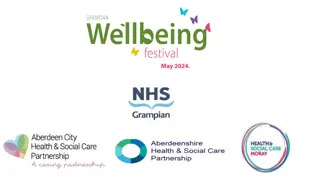


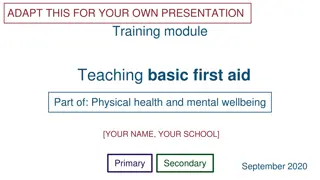
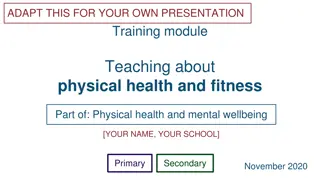
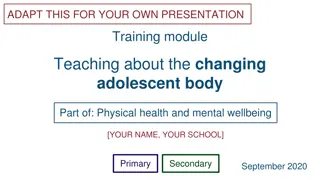
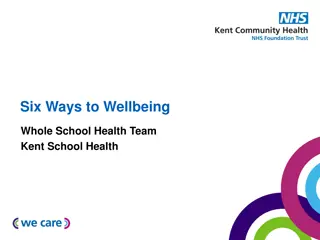
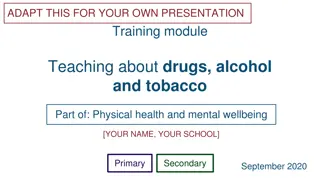
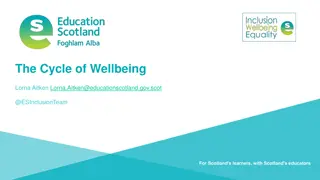
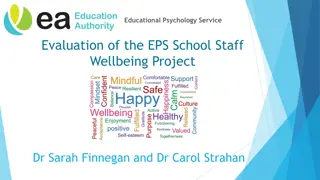


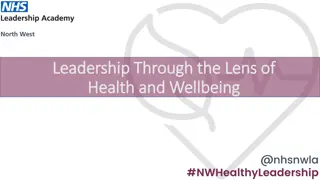

![Teaching Health and Prevention at [Your School]: Training Module for Physical Health and Mental Wellbeing](/thumb/167013/teaching-health-and-prevention-at-your-school-training-module-for-physical-health-and-mental-wellbeing.jpg)
